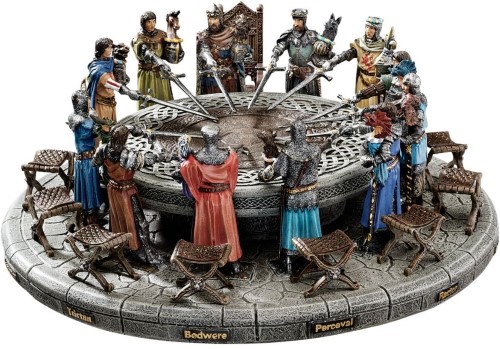
Featured Blog | This community-written post highlights the best of what the game industry has to offer. Read more like it on the Game Developer Blogs or learn how to Submit Your Own Blog Post
Strategy Guide to Selling Your Ideas to Your Boss, Coworkers, & Minions
Much of life is selling.The developer of Archmage Rises shares proven techniques he learned from the corporate world, indie dev, and entrepreneurship - so you don’t have to.


Much of life is selling. Even if it is trying to get my three year old to go to bed. Or convincing my wife playing Hearthstone is research. So knowing and practicing sales technique can be very helpful in everyday life.
If you think you deserve a raise, you are selling an idea.
If you want your team to crunch to hit a deadline, you are selling an idea.
If you want to add a feature to the game, you are selling an idea.
The movie Inception illustrates selling well: you are trying to place a thought into someone else’s brain. Defense mechanisms (good or bad, intentional or not) are prevent the transplant from taking place.
1. Spawn Point
About a year ago, I wrote 12 Tricks to Selling your Ideas, Your Game, & Yourself. I focused on techniques to sell your ideas to strangers (meaning customers, publishers, strategic partners, journalists, and financiers) that range from neutral to disinterested.
At the time, I said if people liked the article, I would write a second part on how to sell internally. By internally I mean people you already know and work with:
Up: to your boss
Down: to your direct reports
Laterally: to coworkers or just general people that don’t have to listen to you
Well it proved popular, so I feel bad I never made good on my promise until now. This article stands on its own but I view them as a complete set. This article is about how to apply some of those techniques in an entirely different context.
Who is this Guy?
I like to know who is giving me advice before I take it. A quick summary: I’ve worked in software E-commerce/Mobile for the last 20 years selling and managing over $20 million in projects. I used to be a sales trainer in the head office for one of Canada’s largest electronics retailers. I got into game development professionally 3 years ago. I’m a serial entrepreneur with five vastly different businesses employing about 30 staff across all of them. I wrote a more detailed bio of my sales experience in the previous article.
Why Use The Term “Selling”?

The transference of an idea with little to no resistance is teaching.*
The transference of an idea that has to overcome resistance (obstacles like defensiveness, busyness, disinterest, or just plain old not liking you) I call a Sale.
(* I recognize most teachers encounter resistance, which is why their job involves a significant amount of sales work.)
To successfully navigate someone’s resistance to your idea, to the point where they agree or even think of it as their own idea, is “closing a sale”.
Just because money doesn’t change hands doesn’t mean you haven’t made a sale.
The Core of Selling
To sell someone you have to show what’s in it for them.
Simple, not easy.
The headline for every article you have ever read (including this one!) has to convince you there is something of value in it for you. Something to learn, something not to do, something to pass on to someone else so you can look really clever. :-)
Strategy 1: Learn How to Sell Up (To Managers)

Most everyone reports to someone. I’ll refer to this person, lead, group, or committee as the manager. Managers come in two flavours: terrific and terrible. You might think there is a third flavour: mediocre, but that is just a twist of the two flavours together, like a chocolate and vanilla soft serve ice cream cone. Your first step is to figure out which parts of your manager are vanilla and which parts are chocolate. :-)
If you are a two person indie team, you probably don’t use the term “Manager” and don’t think of it that way. But like communism proved, even in a team of equals some are more equal than others (worthy of its own article). So even in an indie team someone is still filling the role of manager. Indies have some extra challenges, as we’ll see later.
In the early 2000’s I spent 5 years at one of Canada’s largest ecommerce companies. As far as managers go, I didn’t have a very good run: started with a terrible manager, then terrible, terrific, and finally really terrible. I quit because of the last one.
The core of selling is showing “what’s in it” for them. What does a manager want?
A terrific manager wants:
Whatever is important to his/her boss (key metrics)
However their compensation is calculated (bonuses, usually driven by key metrics)
Successful projects
A well-functioning team, firing on all cylinders, with good morale
Recognition for the good work they do
Improvements or efficiencies to be found in current operations
Long-term success for the team, department, company, and stakeholders. They plan to stick around.
A terrible manager wants:
The perception things are going well. And some great excuses in their back pocket for the things that aren’t.
To maximize their compensation (bonuses and such) at any cost
Successful projects
The team to take as little of their time and effort as possible. If everyone else just did his or her job, everything would be fine!
To be left alone as much as possible. They don’t want people to bother them. The more time people spend with them, the higher chance it be revealed they are in over their head.
Everything to stay the same. Definitely don’t rock the boat. They are likely having difficulty coping with how things are now, so any changes will only make their life more difficult.
Short term success for themselves. They will leave the position or company as soon as they can, it’s a race before they are found out and fired.
Indie Woes: Who is the Manager?
Indie teams usually start with a couple of friends or students jumping into making a game. Because, you know, games are really easy to make! (The tools got easy, game making is still hard.)
I have experienced two corporate partnership breakdowns and seen more. I’m currently mentoring 5 entrepreneurs. One tenant each one of them, universally, ignores is my advice to formalize the roles.
Write down exactly who is responsible for what.
Not just who does programming and who does art. That’s easy. But who makes scheduling decisions, who makes financial decisions, who makes team member decisions? Yes, it is assumed you do those things together, but what about the times when you disagree? That’s much thornier.
If you do this, when things get hard (they will), more complicated (they will), and you feel like choking each other (you will), everyone is on the same page about who needs to make a decision. The person responsible for making a particular decision is “the manager” for purposes of this article.
Even though my mentees know they should clarify roles, they don’t. So I am thrilled to now be ignored by a larger audience on this point. :-)
Advantages of Selling To a Manager
As a minion (I use the term affectionately) it may seem like you are at a disadvantage selling to your manager. That’s not necessarily true. You have little control over your boss, but you do have influence.
Depending on how good of an employee you are and how important you are to the team, you are hard to replace. Trust me, even crappy employees are hard to replace! I don’t know anyone that likes going through the recruitment process (ok, maybe HR people but that’s about it). So your manager is at least somewhat willing to give you an opportunity to speak. Contrast this to a member of another department who doesn’t even have to give you the time of day. Or external sales where the customer doesn’t have to even pick up the phone or answer the email. You’ve already overcome the hardest part of making a pitch: just being heard!
Being in a position of little control means you have a more pure sales challenge to perform. Either you make your case and your boss says yes, or you don’t. It is not this simple when you Sell Down (as we’ll see later).
Know your Audience, Know your Angle

Most people pitch based on what excites themselves rather than what will excite their audience. That’s ok, it’s naturally how we talk with friends and family about the latest movie we enjoyed, but it is a rookie mistake. You need to take an angle that will be compelling to the audience and get excited about that.
You can’t sell a PS4 game to someone without a PS4. The more you know your audience, the better you can sell to them based on their needs and motivations. The advantage of internal sales is you likely do know the person well. This is a huge advantage.
Scenario:
Your idea is to move the development team to a new kind of methodology (SCRUM or whatever).
You have a terrible manager motivated just to keep things the same.
Angle:
It would be a mistake to talk about all the wonderful benefits to the team, morale, and long-term success of the company.
Instead, focus on how the new process would actually require less of his/her involvement. With the new fancy tools and automated reporting a lot of the “management” of the project falls on the team members, freeing up your manager to do what they do best. (Don’t mention what they do best is screwing around on facebook, that won’t help you :-) )
How do you come up with an angle?
Map it out the same way you would a tough boss in a video game. I spent a few minutes thinking of one of my managers and wrote out their seven motivations. I knew their motivations from observance. I worked with this person for several years.
If you feel ill equipped to map it out yourself, talk it over with a team member. Probably the two of you could come up with a fairly complete picture.
Pro Tip: You will be tempted to turn this into a gossip session. That doesn’t help anyone and will not help you understand their motivations. Try to just let it go that you have a terrible manager and just focus on trying to understand how they think.
Now if you are really eager, take the opportunity to chat with your manager about what motivates them. It is very weird for a subordinate to do this, but regardless of where your relationship is at with your manager it will likely improve things. First, people enjoy talking about themselves. Second, a deep human need is to be understood by others. So if you go into the conversation purely to hear them talk about themselves, so you can understand them better, wowzers, they’ll think you are great!
Manager Conversation Starters:
Why did you get into ?
This is like asking a couple how they first fell in love. Knowing their “first love” gives you a lot about their motivation.
What do you enjoy about it?
This tells you what motivates them now.
What would make your job easier?
This pretty much tells you exactly the angle to use when pitching ideas.
What about work keeps you up at night?
Different way of asking the question above.
Where do you see your career going?
This gets at personal long term goals which can reveal a lot about motivation.
Pro Tip: The above questions are similar to the ones I use when interviewing candidates. Knowing someone’s motivations is vitally important when working with them!
Help Push Your Manager Up
Zig Ziglar is a salesperson and motivational speaker. In one of his books he explains many people are trying to pull themselves forward, to climb higher on the corporate ladder. Instead, we should be helping those around us so they push us up the corporate ladder. This is a business implementation of the golden rule: to treat others how we want to be treated.
Managers should be trying to work themselves out of a job. Why? If their team is completely dependent on them, how can the manager possibly leave their current position to perform another one?
Sadly, many of us strategize at the dinner table on how to get our managers fired, not promoted. As a good employee, your motivation should be how to get your manager promoted.
If you focus on how to push your manager up, you will be target-locked on their motivations and therefore able to know the angle to pitch.
Indie Woes: Friends as Managers
In indie dev there aren’t promotions because everyone is just “doing stuff”. But indies to face an additional challenge of a friend being a manager.
I have become the manager of four friends at four separate times. If you were friends first and they became a manager over you, this can lead to issues because the relationship now has this new dynamic of an imbalance of power. If you became friends while working together, that generally is ok because the relationship was formed while they was an imbalance of power.
These are really thorny issues, so here are some general tips to help you work better together:
1. Respect the position, if not the person.
You know probably more than you should about this person. You probably don’t look up to them in the traditional corporate sense if you have a pic of them mooning you. So at least give them the respect due to the position. Your role is to be a good follower, like Sam Gamgee, not to prove you are still equals by undermining your friend.
2. Have some healthy boundaries.
You probably spend a lot of time together. Try not to mix your work time and fun time. Shooting the breeze about work and brainstorming while playing Borderlands together is fine. But if you have something serious to say, don’t do it while in a Destiny fireteam. Wait until the next working period and bring it up then.
3. They are in over their head.
Part of the fun of being indie is you get to do jobs no right thinking person would ever give you. :-) This is how we learn. So if you are on an indie team, it is likely everyone is doing a job that is over their head, and that leads to mistakes. Lots of them. This is the price of admission.
As an indie you should have high standards. But you should also be more forgiving than usual while everyone figures out this thing called game dev.
4. It’s hard on the manager too, even if they don’t admit it.
Managing a friend seems like it would be easier than managing a stranger, but it isn’t (usually point #1 is a culprit). Try to be extra understanding.
For some reason we do the opposite. If your manager makes a decision you don’t like, you’ll just walk right in and start complaining about it. This forces the manager into a position of having to explain every little thing all the time. That isn’t healthy for either of you.
Try and give the benefit of the doubt and just move forward on the game.
Strategy 2: How to Sell Down to Employees

Selling ideas to direct reports is where I now spend most of my time. It is by far the hardest. That sounds counter intuitive so I’ll unpack it a bit.
If you are the manager and you tell a subordinate to go draw triangles for 10 hours and they do it. Did you make a sale that drawing triangles for 10 hours is a good idea? Not necessarily. Because you have control, at some level they have to do it or face repercussions: get transferred, get worse assignments, get a lousy schedule, fired, etc. People could be doing what you want out of fear, obligation, or duty, not because they believe or buy into what you say.
In my experience, most employees are intimidated, at least a bit, by the control factor. It may even be subconscious conditioning from previous work experiences or culture. This means employees will only push back on an idea a little, but not nearly as much as if it were a co-worker.
This is why Selling Up is so much easier. It’s pure. It’s simple. Ideally, you succeed on merit alone.
I come from the modern management mindset where I really care about motivating and unleashing the potential of my people. I want to work with people more talented and experienced than I, so I can get better results than I would on my own. I want to work with 5 star people; getting the right people on the bus and the wrong people off the bus, to quote Jim Collins. I care much more about people catching the idea than doing a task as I ask.

When you have the power, like my signature literally at the bottom of some employee paychecks, it is like a giant megaphone is glued to the front of your face. Even when you speak gently it is heard with a booming echo.
Here’s a typical indie game dev scenario:
The artist on my current project, Archmage Rises, is a contractor. I ask him to make some cool looking mage picture. He works hard and sends me something back that is well done. In reviewing it I think it is missing something, maybe it should have snakes/unicorns/more fire/less fire/or even red lines with a green pen.
In the contracting world it is very tempting to just placate the boss, do the job, and move on to the next thing.
Here is a typical business management scenario:
I want more customers to rely on the grocery store for their everyday food needs. By extending the close time by 2 hours, we can send a solid message to the community that we are here for you when you need us. Extending the hours requires more complicated scheduling, hiring additional people, training, and trusting different employees to close the tills at night.
To the manager of the grocery store, my idea introduces a lot of hassle with questionable gains. She is skeptical the increased sales will even cover the additional cost.
How do we resolve these issues without the employee just saying “fine, whatever” and doing it?
Talk about the What and not the How

The What is the vision, the goal to achieve.
The How is the concrete implementation.
The What rarely changes form, it either is a good or necessary idea or it isn’t. There are many ways to implement a What as a How, some more obvious than others.
There are two reasons to avoid talking specifically about the How with the people you manage.
The first is everyone can get caught up in a debate about the How alone and completely forget the What. This is common with implementers (coders, artists, designers, etc.) as opposed to managers who simply pass the How along to their team.
If I was to say to my programming team I want to implement a global leaderboard and I want the server portion done in assembly, they will rush like sharks to chum to the ludicrous How portion. They will debate what a bad choice assembly is. Even if the meeting ends with agreement to do the server side in PHP, all that happened was everyone being convinced implementing a leaderboard in PHP is better than implementing a leaderboard in ASM. What didn’t happen is the team discussing and catching the vision of why a leaderboard is even valuable at all. The How diverted all the time and energy away from a valuable conversation about the What.
The second reason to avoid the How is your team should know the best way to implement a What. There is a reason they are full time modellers, level designers, or coders and you are not. At most, if you are leading a team, you are only an implementer part time.
So just bring them the What:
1.We need a global leaderboard and it has to perform fast!
2.I need a background that says “seductive influence”.
3.We need a way to convince customers “We’re here for you!” if they suddenly need something at dinner time.
Let them come up with the Hows. You may be amazed at what the combined IQ of the room can come up with.
As a counterpoint to not giving a How, you do need to make the What idea concrete to the team. A suggested How goes a long way to making a concept concrete and easy to understand. So my actual point here is be very clear and committed to the What while more vague and flexible on the How.
Finally, as a manager of creative types, recognize they got into this field of work because they enjoy work of translating Whats into Hows. The people I work with would much rather be told “I need something that says ‘I’m powerful!’” rather than “I need a sword with 6 spikes. Two spikes this long, one this long, three this long. Use color #FF23BD for 80% of it.”
Sharing Difficult Information (Lead them to Water)
Sometimes you have to share an idea or information you already know will be difficult to hear. Perhaps the schedule has been cut by two months for financial reasons. Or the game needs to go in a drastic new direction than what you started making.
No one likes to be told. Everyone likes to be led to water.
The key is to guide a conversation where you lay out the parameters of the decision without actually giving the conclusion. Each parameter is a closed door, and as the team explores the problem with the closed doors eventually (with your help) they will come to see the only door open to them is the concept you came to bring them.
I’ve had the dreaded scheduling conversation more than a few times in my career. Usually it is due to changing financial or customer circumstances and not anything in our direct control. The goal of meeting with the team is for them to catch the reason why the schedule needs to change. When people understand the reason, they may not like it, but they at least get onboard. Those onboard can help convince those who don’t get it or refuse to get it right away.
The poor way to have this meeting is just to go into the room, say “Due to circumstances out of our control the schedule has to be moved up 2 months. Any questions?” Now you are in the middle of a hostile confrontation with the team. Tempers could rise and you may have an insubordination issue. All this could be avoided.
The better way to go is to go into the room and lay out the problems:
“We thought we could finance this project for 4 more months, we were all working toward that goal, but due to the sharp decline in Atari Jaguar users, we just won’t have the money. We need to figure out what we can do.”
Immediate questions that will come up are how an external source can solve our problem. Can we find more money? Is there another source of revenue? Can we sell the gold plated toilets from the executive washroom?
This is where you need to close the door on an external solution. This will move the thinking toward what we can do to solve the problem instead of what others can do.
Eventually the question will come up: “How much money/time do we have left?”
“About 2 months”.
When everyone understands the hard boundaries of the problem state, now the team is thinking how they can make some semblance of the project releasable with the resources (2 months) they have. Now the conversation is constructive, with people throwing out suggestions. Who knows, maybe by cutting this feature and changing that over there, the project could be wrapped up in 6 weeks instead of 8.
I’ve been in both types of meetings: the hostile ones and the disappointed but creative problem solving ones. The former is quicker and takes less effort for the manager, but generally, you have only told an idea not sold an idea. You will likely have to spend more time on the fallout dealing with poor morale, bickering, or even people quitting. The second takes more time up front, but if the idea is bought by the team, as disappointed as they may be, things go well.
I’ve observed team morale is affected by how many times you have these kinds of meetings not usually the topic of the meeting itself.
Try this Sneaky Sales Technique: Hold the Marker

This technique is sneaky and powerful. If you are a terrible manager or a super villain, you are not allowed to use it. This one is only for good guys with the purest of intentions.
People buy into an idea they helped create rather than one they were told.
You have a difficult idea to convey. The best way is Inception: to make the team think it is their own idea. One way to achieve this is to hold a brainstorming meeting. Except you are not brainstorming to come up with any solution, you want them to brainstorm to your solution.
Begin the meeting with you standing at the whiteboard with the marker. Describe the problem and the parameters so everyone is on the same page. Then start the discussion and say that you will write the best ideas on the board. During the discussion, anything that is similar or helpful to your goal you affirm by saying something like “Oh that’s a good idea!”, then write it on the board. When writing summarize in your own words that better match your goal. So if the person said “we should give away free copies to celebrity pets” you can reword that to “have savvy targeted promotions”.
If a suggestion is antithetical to your goal solution, don’t write it on the board. Either let the conversation pass naturally, or question it, or try to see if they can agree it is covered by something already on the board. If someone calls you out saying “Are you going to write that one down?” then you have to.
After some time, review the items on the board. The ideas you like are on the board but the team will feel they are our ideas not your ideas. This is the goal of the exercise.
If there are some ideas on the board opposed to the way you need to go, you can prune the list by doing a simple feasibility discussion. Tell everyone we should review the ideas thus far. Since you are leading the meeting, start with a few of the ones you like and say something good about them. Then ask “Can we agree it should stay on the board?” When you get to one you don’t like, list the problems with it and then say “Good idea, but probably not practical. Can we take it off?”
When you are done culling the list, now you only have ideas you like on the board and everyone is in agreement they are good ideas. You didn’t have to convince anyone, they convinced themselves to buy into those ideas.
When I look back over my career I think most of the brainstorming meetings I’ve been in where actually done this way. Now knowing this technique, if I find myself in a brainstorming meeting I will volunteer to be the guy at the board or, failing that, I’ll suggest everyone get a marker so when they have an idea they can go up and write it on the board. And if that doesn’t work, then I’ll be the annoying guy saying “Are you going to put that on the board?” :-)
Why is Employee Buy-in so Important?
If you tell your team to do something, and they do it, isn’t that really the goal?! Why mess about with this long drawn out hand-holdy meeting stuff?
A motivated employee who catches the idea will work at their full capability. Someone who is just following orders, at best, puts in a half effort. I have found the difference to be more extreme in highly creative disciplines versus purely conceptual disciplines.

This was a hard won lesson for me as a manager.
I was working at the e-commerce company. I was recently promoted to manager of the software team I had been on for several years. We were given a new project that required a drastically different technical architecture than the one used by all of our software. Fortunately, it would run in isolation so it didn’t have to conform with or talk to the legacy system.
Early in the project we were evaluating different technical architectures, it came down to two: one I put forward and one a developer with more experience and higher pay check but newer to the team.
My design was a more simplistic one (I would argue elegant, but I’m biased!) while his was more sophisticated, complex, and I ultimately felt harder to maintain and extend.
After a team meeting in which we debated the pros and cons of each other's architecture (he didn’t seem at all intimidated I was his manager), it was now my call as to which way we would go.
I agonized over this decision, as mine was superior in several ways over his. But at the end of the day, I wasn’t the one who was going to program it. He was, with the rest of the team helping him. I ultimately decided an 80% solution done with 100% effort was better than an 95% solution done with 50% effort.
I told the team we would go with his solution. He was thrilled. He worked extremely hard on it. He finished it in less time than he even asked for. It met all of the project objectives. And we worked well together over the next few years.
Having your team believe in what they are doing is the primary call of any manager.
Indie Woes: Team Morale
Overworked. Underpaid (if paid at all). Overwhelmed. Questionable goals. No end in sight.
Nevermind the rest of the team, this is how I sometimes feel on my own project!
The most important asset to an indie dev team is morale.
The will to go on is the fuel that will drive the game to completion. Lose it, and everyone abandons the project.
The indie dev manager must keep morale front of mind when selling to the team. If it’s hard to replace a good employee, it’s doubly true it’s hard to replace a good volunteer!
For my first two indie games I was the manager. I instituted a weekly meeting where we would go for pancakes and talk about the project. It was a project management meeting, but it also had maple syrup. This was a good time to talk with the team about the previous week, the coming week, goals, and a safe place to share feelings. More than once I or someone else would share the feeling of being overwhelmed.
Have a regularly scheduled project meeting as a release valve. Have it scheduled (monthly at a minimum) so people can anticipate it. If you don’t need it and the “business” part only lasts 5 minutes, it’s still beneficial. This is so much better than noticing “wow, morale sucks, we need a meeting!” Fight fires with smoke detectors, not hoses.
Strategy 3: How to Sell to Coworkers

Selling to coworkers, or equals, is a mixture of the techniques for selling externally, internally, up, and down. These techniques are not only for the workplace. They are applicable to politics, volunteer organizations like church or civic committees, or even an esport team.
If you are in an indie team, you are equals but you don’t all have the same roles.
If you are in a company, there are two categories of coworkers. Ones you work directly with, maybe on the same team or at least the same department. Then there are ones from other departments that you may not know at all. Those ones who could have vastly different agenda than your team.
As with selling up, you need to know their motivations so you can choose the right angle. As with selling externally you need to sell the appointment first (to get an audience) not the idea.
The most common scenario for this I’ve experienced is the feature idea. You are busily working away on your game and you suddenly have a feature idea you simply cannot do on your own (either talent or permission). You need others’ help to implement it.
Furthermore, my assumption is that there is some kind of process or final meeting with everyone to determine if your idea will be agreed to or not.
Find a Buddy Who Sares Your Idea

First step is don’t be a lone voice. Mentally, a lone voice is easy to dismiss as an anomaly. If my daughter says she saw a ghost, that’s a little hard to believe. If she and her sister both say they saw a ghost, that isn’t twice as compelling, it’s 100x more compelling!
Start with the friendliest easiest person to talk with about your idea. See if you can get buy in. Keep going until you get a buddy or run out of people.
Foolish people just talk, wise people listen. They may like the kernel of your idea but have a different/better take on it. This refining of the idea is great! The stronger the idea the better it will perform against opposition!
I have always found a buddy helps remove the dross from my idea to reveal the pure gold.
Discover the Objections Early
In North America you can be sued for almost any reason. You receive a nice letter in the mail saying someone is suing you. It contains only the vaguest of information. The next step is Discovery or Examination for Discovery. At this phase, the evidence the claimant has against you is shared. They are legally obligated to share everything they will use against you so you can prepare a proper and thorough defense.
In the working world you need to do your own discovery of all the objections against your idea. But remember, no one is obligated to give you all of them. :-)
The easiest way to do this is to just walk up to them at some point and say, “I’ve been thinking about X. What do you think?”
Your goal is to first find out if they like or dislike the idea, and second what objections they may raise against it in a meeting.
The more objections you can capture at this friendly shoot-the-breeze stage, the better off you are. You can use that information to improve your idea, or at least prepare a solid defense.
Sell One on One

I was in a committee meeting with 11 other people. My time on the agenda came, so I proceeded to pitch an idea for a small budget expenditure. Someone opposed it and everyone agreed with them. My idea was quashed. Later I found out the opponent, a much older wiser man, had spoken to several of the other members ahead of time and pre-sold them on his objections. I was taken by complete surprise in that meeting. That will never happen again.
The more people in the room the harder it is to sell an idea. One reason for this is there are more sources of objections: if one person can only come up with 3 objections, 8 people can come up with 24. So don’t bother.
So before the meeting go to the other team members one on one and try to sell them on your idea. If you can’t convince them in this format, you will have an even tougher time with a larger audience.
Assuming House of Cards is even close to a realistic portrayal of politics, this is how Frank gets his bills passed in the Senate.
Pre-sell everyone on your idea and make “the big meeting” strictly a formality!
Give and Take (Don’t Be a Jerk)

Working well on a team of equals requires you play for the long term not just the now. If you are always certain your ideas are awesome and everyone else’s ideas suck, well it falls to me to be the first to break this to you: you are a jerk. I worked with a guy like this once, I still don’t know why we kept him around.
For your ideas to be given a fair hearing, you have to be seen as a reasonable person.
A reasonable person is sometimes right and sometimes wrong.
A reasonable person supports ideas based on merit not who originated them.
Should you find yourself in a meeting where the winds are against your idea, you can salvage the situation by abandoning your idea and supporting someone else’s. You don’t lose anything in doing this because your idea had no hope anyway. This makes you look reasonable and you potentially gain an ally. The next time you have something to put forward, the person you supported last time is at least more likely to support you. Hey, go to them either as a buddy or a one on one pitch!
Choosing your battles, which ideas to hold onto and which ones to let go, is part of the maturing process of working well on a team.
Indie Woes: First among Equals

Many indie game projects, volunteer groups, and nonprofits have a flat hierarchy. This means the only person limiting your power and influence is you; you have as much influence as you choose to have.
The essence of leadership is initiative. People want to do things, they just get stuck for a variety of reasons. People are willing to follow someone not because they are smart, good looking, or have nice breath (though those can help!); people follow initiative. People like to follow ideas and people that “are going places”. Leaders believe the Nike slogan: they just do it.
Your ideas will be better heard with more influence. You gain influence by taking initiative. So don’t be the guy or gal on the team that says “we should have sharks with freakin lasers on them” be the one that says “we should have sharks with freakin lasers on them and I’m going to investigate it on my own time”. You are more likely to get people motivated and moving in your direction if they see you putting the time in first.
This is how Sid Meier does it. Instead of pitching an idea, he prototypes it and brings the prototype to the team to see what they think. I hope one day he figures out how to make that dinosaur game! :-)
Additionally, your influence goes up if you take initiative on other people’s ideas.
This is the long play, you don’t get immediate results with this technique. But week by week, month by month, people see who you really are and grow to respect you more. It’s like planting seeds. At first you don’t see anything, but if you keep at it, you get a harvest. Not all at once, some seeds grow faster than others, but that’ is the best part of the long play: the results last a long time too!
Conclusion
I was in a meeting with a potential new client. Actually, this was potentially my first client ever, the one that would help me start my software company. We talked about the competitor’s bid verses my bid. Mine was significantly lower but with much greater risk: My company didn’t exist yet nor had I hired my team!
Yet in that meeting the client, someone I had formerly worked with at the eCommerce company, said “Well Thomas, we’re going to go with you because… I trust you.”
Over 20 years I have learned who you are is far more important than who you know or what you know. Despite all the techniques, the advice, the professional refinement, it is your character that is truly your greatest asset in selling you and your ideas. Techniques are just a buff to your pre-existing character stat. Techniques cannot replace a low stat.
I hope this information has been helpful to you as a manager, coworker, or minion!
~ SDG.
If you think I have good ideas, you can read more at my game site Archmage Rises or on facebook or @LordYabo.
If you don’t, well then I don’t know how you can reach me. :-)
Bonus Strategy: How to Ask for a Raise

When I floated this article concept to the Archmage Rises facebook fans (who are the best fans a guy could hope for!) they asked some good questions. Many were interested in how to pitch getting a raise or promotion.
Many factors go into being worthy for a raise. I deal with a wide variety of professions across my businesses: retail clerk, a high-fashion saleswoman, an MBA executive, an artist/animator, an accountant, a sales executive, a game store manager, and a butcher. I have seen these principles work across a variety of professions.
To start, here is the worst “I want a raise” pitch I have ever had:
One of my employees, who was already the highest paid member of the team, wanted a raise. A big one. Like $30,000 more a year. As we talked, the real reason for him wanting such a raise emerged: his brother-in-law just received a $30,000/year raise. His wife, jealous, is bugging him why he doesn’t get a raise like her sister’s husband did. Other than that, he was happy in his job and what he was doing.
Let me think… denied!
Seeing as the real motivation here was showing his wife, in a concrete way, he was appreciated by his employer we decided to buy him and his wife dinner & theatre tickets. His wife got a fancy evening out, she got off his back, and he got back to coding.
Let’s see how you can do a better job than this guy.
Special Note: When I pay my staff, I automatically give them a cost of living increase of 2% each year in January. This effectively eliminates the whole cycle of “I need a raise because I’m not even making what I was a few years ago due to the cost of living going up.” This is important because everything from here on has nothing to do with cost of living, it’s purely: I want a raise.
Principle 1: You are at Your Best Negotiating Position Before You Start
The time you have the most leverage to negotiate your pay is when you are about to start. At this exact moment the company wants you BAD! You are a hero solving a problem for them. If you turn down the job, they have to go through the whole process again to find someone else, and maybe they don’t want that person as much as they want you.
I hired two senior software developers within a month of each other. Both were to do essentially the same job and both had similar skills. The first negotiated a starting salary $15,000 higher than the other guy.
I felt bad after 2 years that the first guy kept making more money than the second only because of what was said in that one meeting. So I decided to correct it and pay them both the same. He was obviously happy when I went to his office, told him he was doing a good job, and he’s getting a $15k raise.
Do your best negotiating up front so you don’t have to rely on having a terrific manager like me. :-)
Principle 2: Understand the Responsibility/Compensation Ratio
I have a simple rule on how people are paid: based only on their capability and responsibility. If their responsibility or capability doesn’t go up, neither does their pay.
This is hard for some employees to grasp depending on their background. Just because you’ve been doing something for a while doesn’t intrinsically mean you are better at it. You could have plateaued a long time ago and are just coasting.
The best argument an employee can make for getting a raise is:
I used to be responsible for just X, but now I am responsible for X and Y.
I used to be capable of only A, but now I am able to do A and B.
Someone who approaches me with this line of thinking gets my full attention. Maybe I didn’t realize they were doing more or are capable of more.
This argument is also very compelling up the chain of command. When I used to have a boss, after the employee made their case to me, I had to go make their case to my boss to get additional budget allocation.
Make your manager’s job easier by giving him a compelling responsibility/capability argument!
Principle 3: You have to Earn It
This sounds so obvious yet I am shocked it isn’t commonly executed.
First, prove you have grown your skills, responsibilities, capabilities before you ask for the raise. The idea of the raise is it corrects an imbalance: here you are, doing all this awesomeness, but still getting the pay of someone far less awesome. Oh the humanity!
At my first web development job I worked across a table from another young developer. I worked my butt off, hit my deadlines, and learned all I could. He worked in the morning and then sat around surfing the web and chatting in the afternoons. He often missed deadlines.
I was his supervisor (scheduling wise, not in charge of his pay) so I asked him why he didn’t work harder. He said, “They aren’t paying me enough. If they paid me more, I’d do more.”
It’s been 20 years and that statement still blows me away! Yet it was a exactly how he felt and lived. I see it all over the place. But it is never going to happen, he’s got it backwards. You work hard first, then you ask for the pay.
A few months later, I got a promotion with significant salary increase. He was fired.
Principle 4: Don’t Extort Me
I was promoted and now responsible for many more people. Unfortunately, our company was losing $1.5 million a month so all budgets were locked. Based on the responsibility/compensation ratio I wanted a raise. $10,000/year seemed like the right number.
I went to my terrific manager and made my case. He agreed with me but said there was just no more money, we were losing too much each month.
He said the only way he could do it is if I went and found another job that would pay me more, and then he could argue to match it. But: I had to be willing to go to that other job if they denied my request. You can’t play this card and then say you were bluffing.
I didn’t think it was right to waste some other company’s time interviewing me, drafting up an offer, just to get a raise at the job I wanted to keep. I understand this is how salary negotiation is done in many places, but the whole thing smells rotten. I won’t play that game.
I totally agree with the argument that market value has increased. Depending on what is hot, certain skills could be in demand and increasing a profession’s wages. At this point I will want to retain my best performers by raising them to the fair market wage, while the others can happily go if they want.
However, if someone came into my office and said they found a position somewhere else for X, would I be willing to match X? I’d shake their hand and find a box to help empty their desk.
Headhunters (recruitment consultants) are a mixed grey area to this principle. I’ve had a staff member come and say a headhunter contacted them through linked-in and offer them a position with more pay. In this case they are coming to me early to determine if maybe now is a good time to move on, or if there is more opportunity here.
As an employer I know this kind of thing happens so it doesn’t make me nearly as upset as the offer extortion. Usually these end up being good conversations regardless of how it turns out. I’ve had people stay and I’ve had people go.
Principle 5: Ask How
This final point is a ridiculously obvious one, but one rarely tried.
I believe strongly in annual employee performance reviews. I have seen first hand the value of them to the managers and the employees. But other than a few years at my software company, it just never seems to happen. I need to improve this.
If you are in a company that has regular performance reviews, then this is the perfect time to have a conversation. If there isn’t anything formal, you will need to initiate.
Don’t have the “I want a raise” conversation. Have the conversation before that conversation which is “How can I best increase my value here?”
As a manager, I’m more than happy to have that conversation. I want my staff to improve, grow, and take on more responsibility. Having them plugged into and aligned with our corporate goals? Oh, that’s a manager’s dream come true!
So talk one on one with your manager about what the next couple of years look like here. What kind of skills will be necessary in the future that aren’t now? What kind of responsibilities could you pick up?
Basically you are asking them to tell you exactly what you must do to Earn It. This is great as it removes all the guesswork.
The only risk is if after you do whatever it is you talked about, is your manager and the business condition still the same? Even if the answer is no, you are still a better more marketable employee by following that plan than if you just did your own thing.
So no matter what happens, you win!
Read more about:
Featured BlogsAbout the Author(s)
You May Also Like







.jpeg?width=700&auto=webp&quality=80&disable=upscale)








